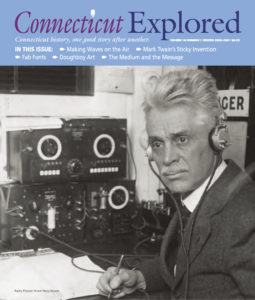(c) Connecticut Explored Inc. Winter 2020-2021
Subscribe/Buy the Issue!
The Winter 2020-2021 issue looks back at the ways in which we’ve communicated in the past, including two 20th-century developments: radio and community access television. But it also looks at perhaps one of the first ways humans communicated—cave drawings. But the drawings in this story were made not by ancient civilizations but by Connecticut doughboys serving in World War I in France (p. 32). The impulse to communicate and record one’s presence by any means possible is timeless.
It may seem a cliché to say it feels as if there are now too many ways to communicate, thanks to newer digital technologies. My sense, though, from robust new and renewal subscriptions and letters from our readers, is that Connecticut Explored—in old-fashioned print—is welcomed into homes and mailboxes now more than ever. We are grateful for that.
And yet, many of us found ourselves during COVID-19 safer-at-home orders increasingly online—and unexpectedly enjoying it! As museums and historical societies moved to virtual programming, I came to appreciate that instead of skipping dinner and rushing out the door to a lecture, I could eat my dinner at home AND enjoy a fantastic lecture. And many of our partner museums found their audiences had become international in scope, attracting participants from near AND far. See Spotlight (p. 51) for what’s on view this winter.
These times and this issue have prompted CT Explored to look both forward and back. In part through funding from CT Humanities that supported expansion of digital history resources, we are adding to our content on CTExplored.org. In our early years we only posted one or two sample stories per issue to our website. We wanted to entice people to subscribe to the print magazine but not give too much away. But we realized that a wealth of fantastic stories was essentially locked away in early print copies—and that wasn’t doing anyone any good.
In July we were awarded a small CT Humanities “Quick” grant, which we used to pay three under-employed museum staff members (whose hours had been cut due to COVID-related museum closings earlier this year) to help with the project. We’ve now added more than 75 stories from our first 10 years, stories like “Sophie Tucker: The Last of the Red Hot Mamas.” This story about the popular entertainer now features more images than we had when it appeared in the Fall 2006 issue, and it links to related stories on our own site, Grating the Nutmeg episode 101, and the Jewish Historical Society of Greater Hartford’s online exhibition about Tucker. Read, see, and listen to a great Connecticut story!
We’ve also created a new Topics section of the website where you can find stories organized by topic across all 73 (and counting!) issues.
Just as virtual programs and exhibitions are not the same as being there in person, CTExplored.org doesn’t replace the joy of the latest issue arriving on your doorstep. Stories available on CTExplored.org fill a different need, such as access for students and teachers in a distance-learning classroom, people exploring their family history from out of state, scholars and historians researching a project, and the person with a question best answered through a quick “Google” search. We also, of course, hope they entice more subscribers to the wonderful experience that is Connecticut Explored.
We hope, too, that we can count on your sustaining subscription dollars and your Friends gifts. It’s truly been our subscribers’ and organizational partners’ steadfast support of CT Explored, and letters like Russ Jones’s (see page 10), that keep us going into our 19th year.
Happy New Year!
GO TO NEXT STORY in Winter 2020/2021

